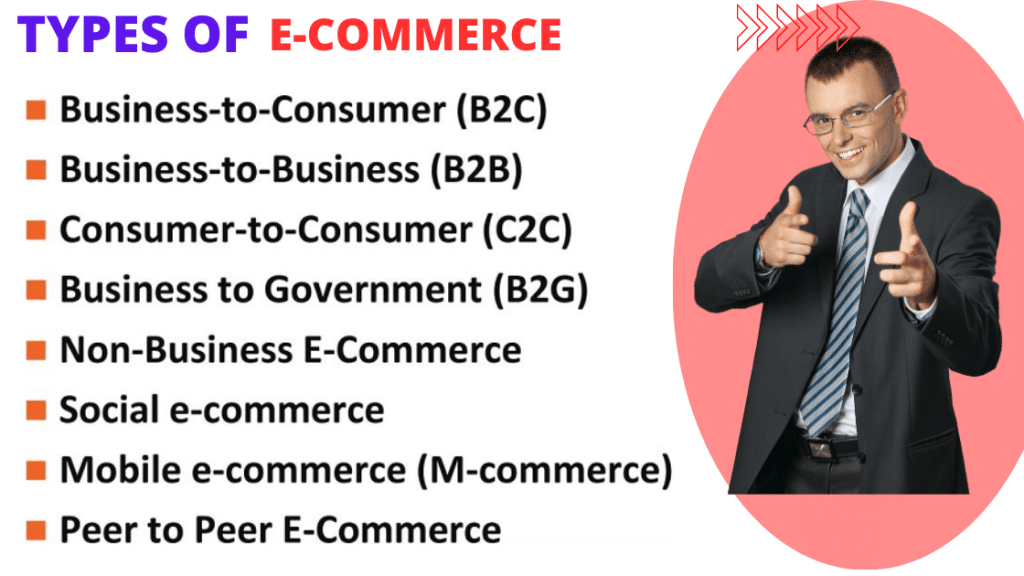E-commerce has transformed the way businesses operate and the way consumers shop for products and services. With the advent of the internet, companies now have the ability to reach a global market and operate more efficiently with digital technologies. If you’re starting a business, it’s essential to understand the different types of e-commerce available and choose the one that fits your business model and goals. In this article, we’ll explore the various types of e-commerce, including B2C, B2B, C2C, C2B, B2G, B2B2C, and D2C, and help you determine which type is best for your business.
What is E-Commerce?
E-commerce has a broad definition that encompasses various types of transactions and business models. For example, it can refer to a large e-commerce business that sells goods directly to consumers, an online marketplace that allows third-party sellers to offer their products to consumers, or a small business that sells products through its own website.
Electronic commerce refers to the buying and selling of goods over the internet. E-commerce businesses typically operate through a website or online marketplace and allow customers to browse, select, and purchase products from the comfort of their own homes.
E-commerce refers to the buying and selling of goods and services, or the transmitting of funds or data, over an electronic network, primarily the internet. It has revolutionized the way in which businesses operate and has made it possible for consumers to purchase products and services from the comfort of their own homes.
Types of E-Commerce: A Comprehensive Overview
1. B2C (Business-to-Consumer)
B2C e-commerce refers to transactions that take place between a business and individual consumers. Online retail is the most common example of B2C e-commerce. In this model, businesses sell products directly to consumers through their website or online marketplace.
2. B2B (Business-to-Business)
B2B refers to transactions that take place between businesses, such as the sale of wholesale goods or the procurement of supplies. Businesses can use e-commerce platforms to find suppliers, place orders, and manage their supply chain more efficiently.
3. C2C (Consumer-to-Consumer)
C2C e-commerce refers to transactions that take place between individuals, such as through online marketplaces like eBay or Etsy. In this model, individuals sell products or services to other individuals.
4. C2B (Consumer-to-Business)
C2B e-commerce refers to transactions in which individuals sell products or services to businesses, such as freelance work or the sale of content through a platform like Patreon.
5. B2G (Business-to-Government)
Business-to-Government e-commerce refers to transactions that take place between businesses and government, such as the procurement of goods or services by government agencies.
6. B2B2C (Business-to-Business-to-Consumer)
B2B2C is a business strategy in which e-commerce companies and portals partner with businesses that sell goods and services to consumers. Together, the two businesses market goods and services that benefit both parties.
7. D2C (Direct-to-Consumer)
D2C refers to businesses that sell products directly to consumers without intermediaries such as retail stores or online marketplaces.
Value Delivery Methods for E-Commerce
1. White Label
White label refers to products that are manufactured by one company and sold under another company’s brand. In e-commerce, white label products can be sold through a variety of channels, including online marketplaces and direct-to-consumer websites.
2. Private Label
Private label refers to products that are manufactured by one company and sold under the company’s own brand name. Private label products are typically sold through the company’s own website or online marketplace.
3. Wholesaling
Wholesaling refers to the sale of goods to retailers, who then sell the products to consumers. In e-commerce, wholesaling typically takes place through B2B transactions.
Benefits of E-Commerce
One of the key benefits of e-commerce is convenience. With just a few clicks, consumers can purchase products from anywhere in the world, at any time of day, without having to leave their homes. E-commerce has also made it easier for businesses to reach a global audience, which can help to increase sales and revenue.
Another benefit of e-commerce is the ability to offer personalized shopping experiences. With the help of data analytics and other technologies, e-commerce businesses can gather information about their customers and use it to offer tailored recommendations and discounts. This can help to increase customer loyalty and satisfaction.
However, e-commerce also presents challenges, such as the need to ensure the security of sensitive customer information, comply with various regulations, and navigate a highly competitive landscape. For example, businesses must take steps to protect their customers’ financial information and personal data, as well as comply with regulations such as the General Data Protection Regulation (GDPR). in the European Union and the California Consumer Privacy Act in the USA.
Overall, e-commerce has had a profound impact on the business world, making it possible for companies of all sizes to reach a global audience and offering consumers unprecedented convenience and choice. As technology continues to evolve, it is likely that e-commerce will continue to grow and change, presenting both opportunities and challenges for businesses and consumers alike.
What is an ecommerce website?
An ecommerce website is an online platform that allows individuals or businesses to buy and sell goods and services over the internet. Ecommerce websites typically have a shopping cart feature that allows customers to add items to their virtual cart and proceed to checkout where they can make payment and provide shipping information. The payment process can be handled through various methods, including credit cards, PayPal, or other online payment systems. An ecommerce website can be a standalone platform, or it can be integrated into a larger website for a business or organization. The goal of an ecommerce website is to provide a convenient, secure, and accessible platform for conducting transactions online.
Payment Methods
In e-commerce, payment methods refer to the various ways customers can pay for the goods or services they purchase online. Some common payment methods include credit card payments, bank transfers, PayPal, and digital wallets like Apple Pay and Google Pay.
Credit card payments are the most widely used payment method in e-commerce, as they offer convenience and security for both the buyer and the seller. However, credit card transactions are subject to chargebacks and fraud, so it’s important for e-commerce businesses to implement secure payment gateways to minimize risk.
Bank transfers, on the other hand, are often used by customers who do not have access to a credit card or who prefer to pay directly from their bank account. This payment method is typically used in B2B transactions and can take several days to process, which can delay the delivery of the goods.
PayPal is a popular digital payment system that allows customers to securely pay for their purchases using their PayPal account. It provides buyers with additional security and protection against fraud, as well as the ability to track their purchases.
Digital wallets such as Apple Pay and Google Pay are becoming increasingly popular as they offer fast and secure payment options for customers who prefer to pay with their mobile devices.
Shipping Options
Shipping options refer to the various ways that e-commerce businesses can deliver their products to their customers. Some common shipping options include standard shipping, expedited shipping, local pickup, and delivery by courier.
Standard shipping is the most basic form of shipping, usually taking 3-7 business days to arrive. It’s the least expensive option, making it a popular choice for customers who are not in a hurry to receive their purchases.
Expedited shipping is a faster form of shipping that can take 1-3 business days to arrive. It’s more expensive than standard shipping, but it provides customers with the convenience of receiving their purchases sooner.
Local pickup allows customers to pick up their purchases from the e-commerce business’s physical location, eliminating the need for shipping altogether. This option is particularly popular for businesses that are located in densely populated areas.
Delivery by courier is a more expensive shipping option that provides customers with a guaranteed delivery date and time. This option is popular for businesses that need to deliver large or fragile items, or for customers who require their purchases to be delivered on a specific date.
E-commerce Regulations
E-commerce regulations refer to the laws and regulations that govern the sale of goods and services online. These regulations vary by country and are designed to protect the rights of both buyers and sellers, as well as to ensure a fair and secure marketplace.
In the United States, e-commerce regulations are governed by the Federal Trade Commission (FTC) and include laws that address online advertising, data privacy, and consumer protection. The FTC also enforces regulations related to telemarketing, email spam, and other forms of online marketing.
In Europe, e-commerce regulations are governed by the European Commission, which implements laws related to consumer protection, data privacy, and online advertising. The European Union also has regulations related to cross-border transactions, which can impact e-commerce businesses that sell products to customers in multiple countries.
In addition to these regulations, e-commerce businesses must also comply with local laws and regulations related to taxes, product labeling, and consumer protection. As such, it’s important for e-commerce businesses to stay up to date on the latest e-commerce regulations and to consult with a legal professional if they have any questions.
What are the advantages and disadvantages of ecommerce?
Advantages of e-commerce include:
1. Convenience:
E-commerce allows customers to shop from anywhere, at any time, without having to physically visit a store.
2. Increased Reach:
E-commerce businesses can reach a larger audience, as they are not limited to a physical location.
3. Lower Overheads:
Operating an e-commerce store typically requires fewer resources and costs less than a traditional brick-and-mortar business.
4. Better Analytics:
E-commerce platforms provide access to detailed analytics and customer data, which can help businesses make informed decisions and improve their operations.
5. Improved Customer Service:
E-commerce businesses can use chatbots, AI, and other technologies to provide quick and efficient customer support.
Disadvantages of e-commerce include:
1. Security Risks:
E-commerce transactions involve the exchange of sensitive information, such as credit card numbers and personal details, making them vulnerable to cyberattacks.
2. Shipping and Handling Costs:
Shipping and handling costs can be higher for e-commerce businesses, as they need to physically deliver products to customers.
3. Shipping Delays:
Shipping delays can be a problem for e-commerce businesses, as they are dependent on third-party delivery services.
4. Competition:
E-commerce businesses face intense competition, as it is relatively easy to set up an online store.
5. Trust Issues:
Some customers may be wary of shopping online, especially if they are unfamiliar with the brand or if the website is not secure.
Conclusion
Conclusion In conclusion, e-commerce has changed the way businesses operate and has made it easier for consumers to purchase goods and services online. There are various types of e-commerce, including B2C, B2B, C2C, C2B, and B2G, each with their own unique characteristics and business models. Whether you’re a business owner or a consumer, understanding the different types of e-commerce can help you make informed decisions about your online purchases and sales.
FAQs
Q: What is e-commerce?
A: E-commerce, or electronic commerce, refers to the buying and selling of goods and services over the internet.
Q: What are the different types of e-commerce?
A: Some common types of e-commerce include B2C, B2B, C2C, C2B, and B2G.
Q: What is B2C e-commerce?
A: B2C refers to e-commerce transactions that take place between a business and individual consumers.



